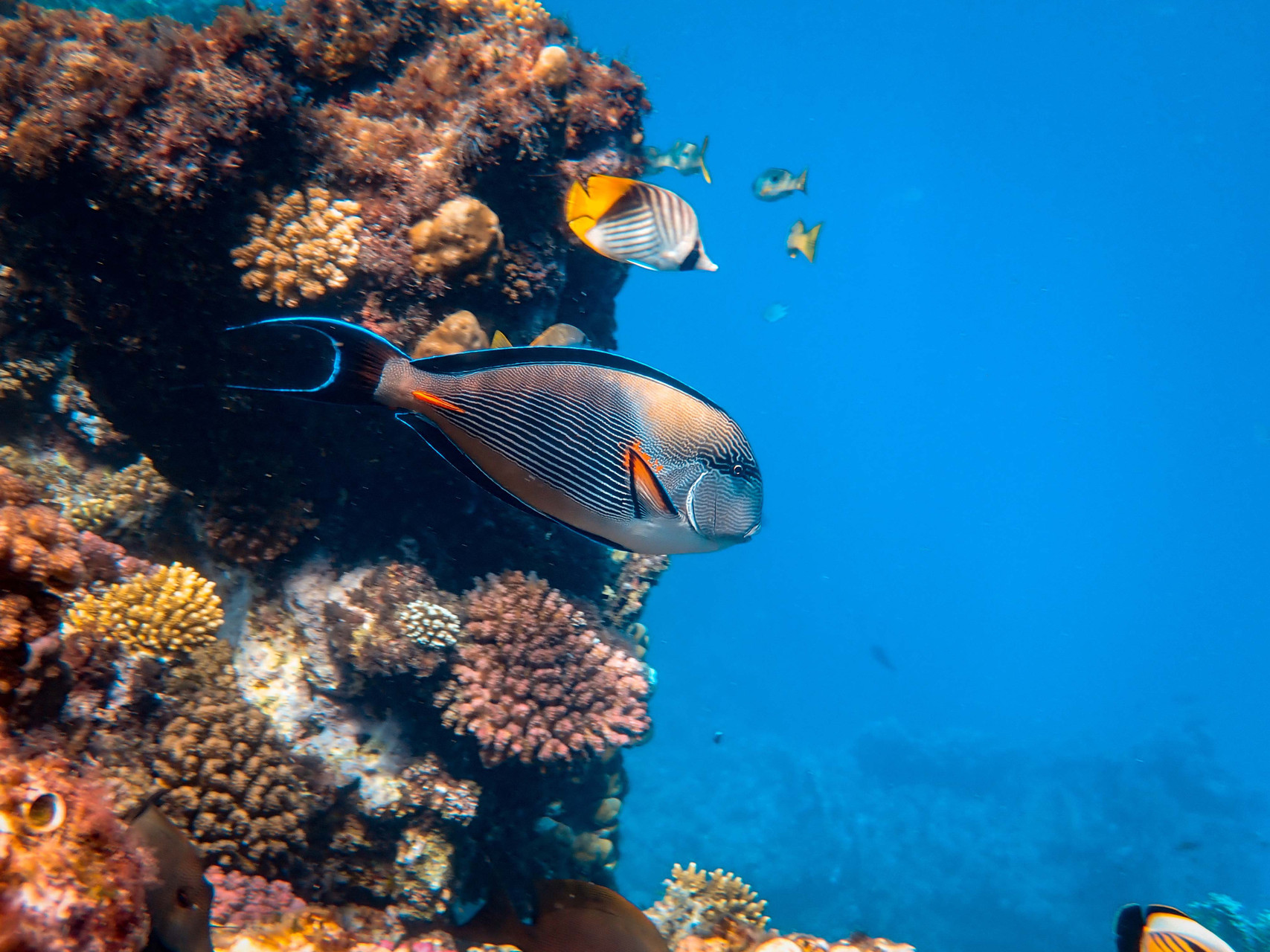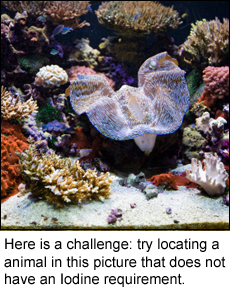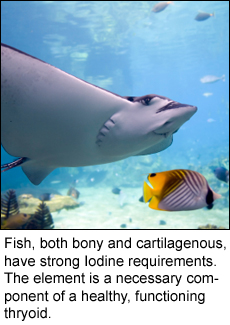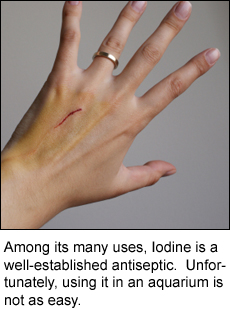Chemistry Corner Your Guide to: IODINE, part 2


In the previous edition of Chemistry Corner, we tackled some of the complexities of Iodine. It is an element which appears in many kinds of biological processes, both in the ocean and on land. In fact, virtually every organism on Earth utilizes Iodine in some capacity. Nevertheless, the precise way that most marine organisms absorb and use the chemical is still unclear.-Though scientist can quantify the proportion of Iodine present in the bodies of such organisms, the elements uptake and subsequent utilization are often wholly mysterious. For aquarists, the uncertainty is particularly vexing. We know our marine charges need the element, but we are perplexed about how it is to be properly provided. This week, we will discuss the vagaries of this element as it pertains to marine husbandry. We will also cover whether supplementing Iodine is even worth doing in the first place.
As previously described, Iodine is a necessary component of marine systems; no one debates this fact. If your marine aquarium contains less Iodine than it should, you will certainly notice problems with your livestock. Fish, for example, have strong requirements for the element, as it is particularly important for proper thyroid functioning. Many people may be familiar with this concept because we too need a properly functioning thyroid. Without going into excruciating detail, the metabolic roles played by the iodine-based thyroid hormones, thyroxine and triiodothyronine, include enhancing cellular respiration, creating proteins, processing carbohydrates, regulating growth, and maturing the nervous system. For lower order organisms (i.e. invertebrates), the responsibility of Iodine is poorly-understood. However, Iodine-deficient systems will produce less growth and coloration in invertebrate ornamentals. Under such conditions, macroalgae cannot proliferate, coralline algae will bleach out, crustaceans will fail to molt, and some corals may wither and die. It is clear, then, that our lack of understanding in no way indicates that Iodine is unimportant. But knowing that iodine is important is not the same as being able to manipulate it accurately.

The Rub(s)
The main problem with providing Iodine to aquarium inhabitants is three-fold: A) We do not know how various aquarium organisms sequester the element, B) We do not know what ionic form is ideal to provide, and C) Most test kits do not take into account the various species of Iodine present in natural seawater, and those that do are expensive. The question then becomes, do we try to control Iodine levels, or do we let them regulate themselves?
In trying to establish the utility of Iodine supplementation, we must first understand that natural seawater contains a relatively low concentration of Iodine, which stays stable at about 0.06 mg/L. However, that measurement represents the sum total concentration of all Iodine speciesvery little of which is actually elemental Iodine (I2). The most common species found in seawater are Iodide (I-), Iodate (IO3-), and hypoiodite (IO-), with surface waters predominated by Iodate. Elemental Iodine is rare simply because it is usually converted immediately, most likely in a spontaneous reaction with water that creates hypoiodite. Thus, it is possible that hypoiodite is the beginning of the biochemical pathway. Things get a little muddled after that; iodate and Iodide are both taken up by macroalgae, but Iodate is demonstrated to be preferable. Iodate is converted to Iodide via this pathway, and anaerobic bacteria conduct a similar conversion.
As the organisms become more advanced, the mechanism by which they absorb Iodine becomes less and less clear. Corals and other polyps may be able to absorb some directly from the water column. On the other hand, they may also be getting their Iodine from planktonic food sources. Likewise, animals further up the food chain are more likely to get most of their iodine by eating it. However, there does not seem to be direct evidence that this is the case. Shrimps, by virtue of their scavenging nature, are probably exposed to ample quantities of Iodine through their dietary choices. Conversely, they may be able to absorb some of the element directly from the surrounding seawater. The same questions persist all the way up the food chain, and a clear lack of scientific data prevents us from comprehending the majority of the Iodine pathway.
In spite of the confusing nature of Iodine, aquarists have long noticed that it is exported rapidly in closed systems. The intuitive answer is to dose Lugols solution, since it is usually already on hand. The chemical we have always used for preventative Iodine dips seems the perfect resolution, as it absolutely elevates levels of the Iodine species most commonly tested for. Unfortunately, it contains no reported concentration of Iodate, which is probably a much more useful form. The real difficulty with Lugols is that it is very easy to overdose. Overdosing Iodine can be deadly to most or all aquarium inhabitants, especially to the bacterial colonies that comprise the biological filter. Avoiding the overdose is tough, not only due to unreliable testing but also because many solutions contain inaccurate or unknown concentrations of Iodocompounds. Moreover, the desired concentration is already quite dilute, so it takes very little Iodine to exceed optimal levels.
Using other Iodine supplements can also be a journey into the unknown. All too often, the labels offer incomplete descriptions of the solution in question. In fact, some labels do not even list the specific ions included. Where they do, the majority simply describe Iodine as an ingredient. To be fair, I have seen labels that give expected Iodine levels, provided the dosing instructions are closely followed. Still, such labels tend not to provide a species-based breakdown, so the specific composition remains unknown. Another thing to keep in mind is that dosing organic Iodocompounds is ill-advised because there is no commonly available test for such chemicals.

To Dose or Not to Dose
In spite of all we have learned about Iodine in seawater, we are still left the question of whether dosing is necessary. The answer is not much simpler now than when we started. Because virtually every marine aquarium inhabitant has an Iodine requirement, it would seem that depletion would a severe problem, but food is likely to provide a significant source of the element for many types of livestock. There are even reports that vegetarian cubes containing Gracillaria. can rapidly bring Iodine past optimal levels in the water column. For carnivores, crustacean-based diets, especially krill, can be an important source of Iodine. Be sure to mix the offerings up though, as krill-only diets can lead to irreversible lockjaw.
If you suspect that there may be some issues with Iodine deficiency, invest in a high-quality Iodine test kit such as that made by Salifert. Generally, their test kits are very accurate, and this one in particular tests for the four main Iodine species, elemental Iodine, Iodate, Hypoiodite, and Iodide. Ultimately, however, the matter probably depends on the size of your system. Small systems will likely do well enough with regular water changes performed using a high quality seawater mix. Large systems, where frequent water changes are prohibitive, may require Iodine supplementation. In these cases, dosing is reasonably safer due to the increased water volume. Restrict the chemicals you dose to those that provide the most descriptive information about the specific ionic components, and their respective concentrations. Dose only after accurate testing has been completed, and always have a water dechlorinator on hand. Dechlorinators have the positive side effect of eliminating Iodine, and their rapid implementation after a suspected Iodine overdose may save your livestock from injury or death.
To Conclude
The final estimation about Iodine is that, while necessary, trying to tightly control it is needlessly difficult in many cases. Unless your livestock exhibits obvious signs of Iodine deficiency, dosing is probably not necessary. Between dietary inputs and regular water changes, Iodine levels usually stay within tolerable ranges. When supplementation is deemed necessary, care must be taken in choosing the appropriate additive, test kit, and overdose antidote. Chances are, you are already providing your aquarium livestock with all the Iodine they need, but in the event you are not, be very careful trying to compensate with supplements.

Works Cited:
Cunningham, J. Iodine Addition to the Marine Aquarium. Aquarists Online. 2007. URL: < http://www.aquaristsonline.com/blog/aquarium-care...>
de Graaff, Van. Human Anatomy, Sixth Edition. McGraw Hill; Boston. 2002.
Goemans, B. and L. Ichinotsubo. The Marine Fish Health and Feeding Handbook. T.F.H. Publications; Neptune City. 2008.
Gozlanan, R. S. and D P. Margalith. Iodide Oxidation by a Marine Bacterium. Journal of Applied Microbiology. 36:3. pp. 407-417. 1973.
Henderson, N. E. and F.L. Lorscheider. Thyroxine and protein-bound iodine concentrations in plasma of the pacific hagfish, Eptatretus stouti (Cyclostomata). Comparative Biochemistry and Physiology Part A: Physiology. 51:4. pp. 723-724. 1975.
Hirano, S., T. Ishii, R. Nakamura, M. Matsuba, and T. Koyanagi. Chemical Forms of Radioactive Iodine in Seawater and its Effects Upon Marine Organisms. Radioisotopes. 32:7. pp. 319-322. 1983.
Holmes-Farley, Randy. Chemistry and the Aquarium Iodine in Marine Aquaria: Part I. Advanced Aquarist Online Magazine. Mar., 2003. 2003. URL: < http://www.advancedaquarist.com/issues/mar2003/ch...>
Sherrill, J., B.R. Whitaker, G.T.F. Wong. Effects of Ozonation on the Speciation of Dissolved Iodine in Artificial Sea Water. Journal of Zoo and Wildlife Medicine. 35:3. pp. 347-355. 2004.
Shomon, M. Iodine and the Thyroid. About.com Online. 2003. URL: < http://thyroid.about.com/cs/vitaminsupplement/a/i...>
Tullock, J.H. Water Chemistry for the Marine Aquarium. Barrons: Hauppauge. 2002.
Tullock, J.H. Natural Reef Aquariums. T.F.H. Publications; Neptune City. 2001.
Williams, K. Reef Tank Additives. Southwestern Michigan Aquarist's Magazine. 1994. URL: < http://www.swmas.org/swam/articles/reef_tank_addi...>